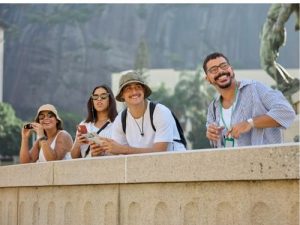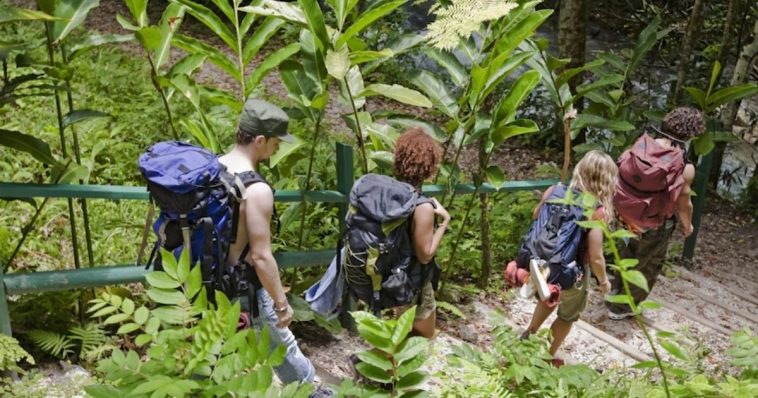Tourism has long been associated with economic benefits and cultural exchange, but it often comes at an environmental and social cost. Enter regenerative tourism, a growing approach that goes beyond sustainability, aiming to minimize harm and actively improve the places and communities it touches. Understanding regenerative tourism is crucial for travelers seeking meaningful experiences that have a lasting, positive impact.
What Is Regenerative Tourism?

Regenerative tourism goes beyond simply reducing the adverse effects of travel—it focuses on actively restoring and improving the destinations visited. Unlike conventional tourism, which often aims to “do less harm,” regenerative tourism seeks to leave a place better than it was found, fostering environmental renewal, cultural preservation, and community enrichment. This can involve supporting local economies, investing in conservation projects, or engaging in cultural programs that celebrate and protect traditions.
Every decision along the journey—from the choice of accommodations and transportation to the activities undertaken—is made with a net positive impact in mind. Staying at eco-conscious lodges that restore natural habitats, participating in community-led tours, or volunteering for local sustainability initiatives are all ways travelers can contribute to the cause. Regenerative tourism transforms vacations into mutually beneficial experiences, where visitors and destinations thrive, creating lasting value for communities, ecosystems, and future generations.
How It Differs from Sustainable Tourism
Sustainable tourism is primarily about minimizing harm—reducing carbon emissions, conserving water, managing waste, and preserving the environmental status quo and the well-being of local communities. It encourages travelers to be responsible and mindful, ensuring that their presence doesn’t create additional strain on destinations. While this approach is essential for protecting natural and cultural resources, it focuses on prevention rather than active improvement.
Regenerative tourism, conversely, takes sustainability a step further by actively enhancing ecosystems and communities. It’s not just about not harming—it’s about leaving a place better than it was found. Examples include participating in beach cleanups, reforestation programs, or supporting community-led projects that generate tangible positive outcomes for locals and the environment. While sustainable tourism emphasizes responsible habits, regenerative tourism encourages travelers to be proactive contributors, transforming each trip into an opportunity for meaningful impact and long-lasting benefits for future generations.
Principles of Regenerative Travel
Several guiding principles help travelers embrace regenerative tourism:
Community Empowerment
- Supporting local businesses, artisans, and cultural programs goes far beyond simple spending—it helps ensure that the economic and social benefits of tourism remain within the community. By choosing locally owned accommodations, dining at neighborhood restaurants, purchasing handcrafted goods, or participating in cultural workshops, travelers directly support the residents’ livelihoods. This strengthens the local economy and preserves traditional crafts, skills, and cultural practices that might otherwise be at risk of disappearing.
- Empowered communities are better equipped to manage tourism sustainably, creating a cycle where residents benefit, visitors have authentic experiences, and local heritage is protected. Families and travelers become part of this positive loop, experiencing destinations in a meaningful, responsible, and mutually beneficial way. Engaging with the community in this way transforms travel from a passive activity into a purposeful exchange that supports both people and place.
Environmental Restoration
- Participating in activities that restore natural habitats, protect wildlife, or enhance landscapes allows travelers to make a tangible, positive impact on the environment. This could include joining reforestation projects, wetland rehabilitation, coral reef restoration, or wildlife monitoring programs, all of which help ecosystems recover from human or natural pressures. By engaging in these hands-on efforts, travelers aren’t just observing nature—they’re actively contributing to its health, resilience, and long-term sustainability.
- Beyond the direct ecological benefits, these activities foster a deeper connection to the natural world. Seeing firsthand the results of conservation work—whether a newly planted forest sapling or a rehabilitated beach—creates a sense of responsibility and stewardship that stays with participants long after the trip. In this way, environmental restoration transforms travel into an experience that nurtures both the planet and the traveler’s awareness of their role in preserving it.
Cultural Preservation
- Cultural preservation in regenerative tourism goes beyond simply observing local customs—it involves actively engaging with and supporting the living traditions of a community. By participating in local festivals, learning traditional crafts, or understanding indigenous languages and storytelling, travelers contribute to the preservation of cultural practices that might otherwise fade under the pressures of globalization and mass tourism. This respectful engagement ensures that cultural identity remains vibrant and authentic, rather than being reduced to a commercialized or superficial experience for visitors.
- Supporting local artisans, performers, and cultural institutions also reinforces the economic and social value of these traditions, allowing communities to sustain and pass them down to future generations. In essence, cultural preservation through conscious travel creates a mutually enriching exchange: travelers gain deeper insight and connection, while communities retain control over how their heritage is represented and celebrated. It transforms tourism from a fleeting visit into a meaningful act of respect, understanding, and long-term cultural sustainability.
Mindful Travel Practices
- Mindful travel practices emphasize making every journey step intentional, with a conscious awareness of how individual choices impact the environment and local communities. Opting for low-impact transportation—such as trains, bicycles, or electric vehicles—reduces carbon emissions while allowing travelers to experience destinations at a slower, more immersive pace. Minimizing waste, from carrying reusable bottles and bags to avoiding single-use plastics, helps protect fragile ecosystems and prevents local environments from being overburdened by tourism.
- Equally important is reducing resource consumption throughout the trip, including water and energy usage in accommodations, dining, and activities. By consciously choosing sustainable lodging, supporting eco-friendly businesses, and being mindful of everyday consumption, travelers lower their environmental footprint while promoting a culture of sustainability. These small, deliberate actions collectively transform travel into a practice of responsibility and respect, where the enjoyment of exploration harmonizes with care for the planet and its communities.
How Travelers Can Practice Regenerative Tourism
Choose Eco-Conscious Accommodations with Regenerative Programs
- Opting for accommodations that embrace regenerative principles transforms a stay into an active contribution to environmental and social well-being. Many resorts, lodges, and boutique hotels now go beyond sustainability by participating in programs such as reforestation, wildlife conservation, or community education initiatives. Staying at these properties means each night contributes directly to projects that restore natural habitats, protect endangered species, and support local communities. Additionally, such accommodations often incorporate eco-friendly design, renewable energy sources, and waste reduction practices, allowing guests to enjoy comfort and luxury while having a positive impact on the environment.
Support Local Artisans and Businesses
- Engaging with local businesses and artisans ensures that the economic benefits of tourism remain within the community. Purchasing handcrafted goods, dining at family-run eateries, or hiring local guides provides travelers with authentic and memorable experiences, while also empowering residents by sustaining their livelihoods and cultural traditions. This conscious support encourages the continuation of traditional crafts, culinary practices, and storytelling, while fostering a resilient local economy. By investing directly in communities, travelers create a cycle where tourism actively uplifts and strengthens the very places they visit.
Participate in Hands-On Projects
- Engaging directly in local projects turns travel into a tangible, positive force. Volunteering for beach cleanups, wildlife conservation efforts, or cultural heritage preservation programs enables travelers to make meaningful contributions to the destinations they visit. These activities help restore and protect natural and cultural resources, providing unique, immersive experiences that deepen understanding and foster a deeper connection to the environment. By actively participating rather than observing from the sidelines, travelers become partners in the stewardship of the environment and the community, leaving a lasting impact beyond their stay.
Travel with Intention
- Intentional travel prioritizes quality over quantity, promoting a slower and more thoughtful approach to exploring destinations. By focusing on fewer locations and spending more time engaging with local communities, travelers reduce carbon emissions and minimize environmental strain while fostering deeper connections. This approach prioritizes meaningful interactions, cultural exchange, and personal enrichment over merely checking off sights on a list. Traveling with intention also allows for reflection and mindful appreciation of each experience, cultivating a more sustainable and fulfilling way to explore the world.
Learn and Share
- Knowledge is a key element of regenerative travel. Taking the time to understand a destination’s culture, environment, and socio-economic challenges enables travelers to make responsible decisions that respect local contexts. This learning can extend to supporting local initiatives, choosing eco-friendly activities, and advocating for the preservation of natural and cultural heritage. Sharing these insights with others—through conversations, social media, or community involvement—creates a ripple effect, inspiring peers to travel consciously and amplifying the impact of regenerative tourism far beyond the individual traveler.
The Benefits of Regenerative Tourism

Regenerative tourism generates a ripple effect that extends far beyond the duration of a trip. By actively supporting environmental restoration—such as reforestation projects, wildlife conservation, or habitat rehabilitation—travelers contribute to healthier, more resilient ecosystems that can thrive for future generations. Simultaneously, engaging with and investing in local businesses, artisans, and cultural programs strengthens local economies, ensuring that the benefits of tourism are shared within the community rather than leaking out to external operators. These efforts empower communities to maintain their cultural and environmental heritage while fostering pride and resilience among residents.
For travelers, the rewards are equally enriching. Experiences become deeper and more immersive, moving past surface-level sightseeing to meaningful connections with people, traditions, and natural landscapes. Participating in regenerative practices nurtures a sense of responsibility and stewardship, inspiring ongoing care for the places visited long after the journey ends. Over time, this approach cultivates a global network of conscious travelers who prioritize sustainability, cultural preservation, and environmental health, transforming tourism into a force for lasting, positive change.
The Promise of Regenerative Tourism
Regenerative tourism transforms the act of traveling into a conscious, restorative practice. By prioritizing community well-being, environmental health, and cultural preservation, travelers can leave a destination better than they found it. Choosing regenerative experiences isn’t just about responsible travel—it’s about creating a world where tourism heals and enriches, leaving lasting benefits for future generations.



